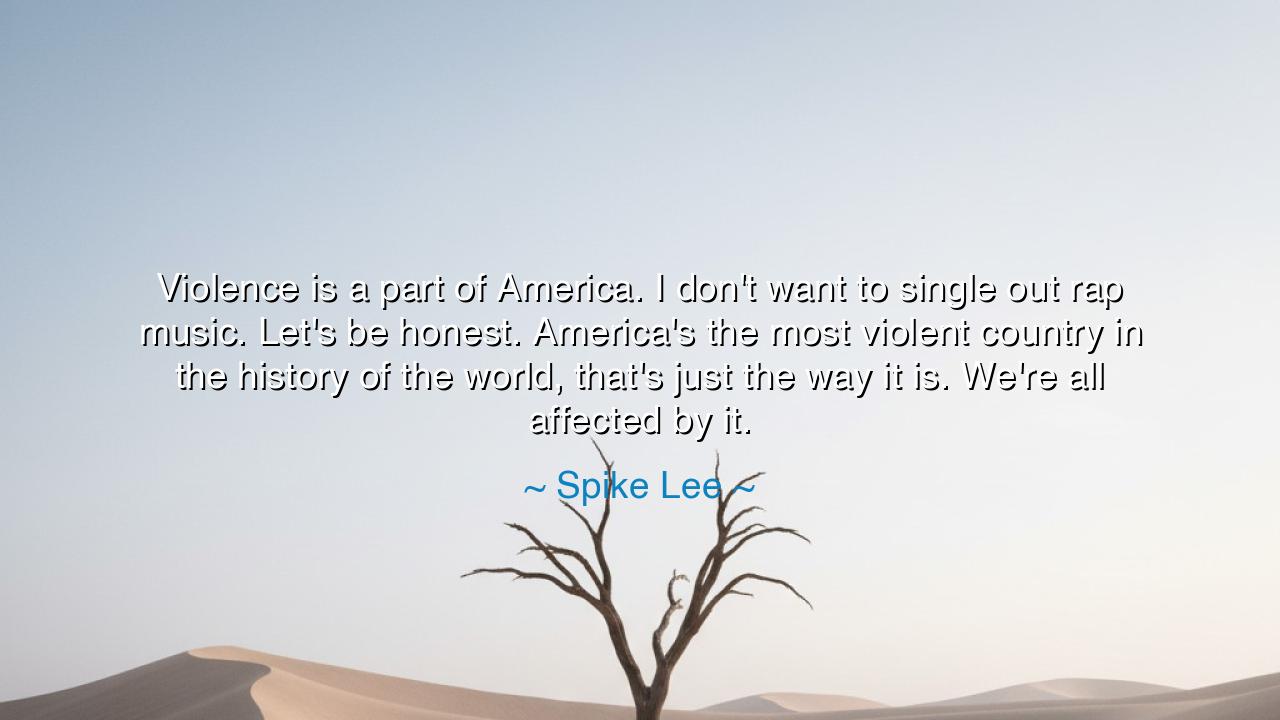
Violence is a part of America. I don't want to single out rap
Violence is a part of America. I don't want to single out rap music. Let's be honest. America's the most violent country in the history of the world, that's just the way it is. We're all affected by it.






When Spike Lee declared, “Violence is a part of America. I don't want to single out rap music. Let's be honest. America's the most violent country in the history of the world, that's just the way it is. We're all affected by it,” he spoke with the blunt clarity of a man who has witnessed the raw edges of society and the echoing consequences of its wounds. His words are not mere criticism of culture or music, but a profound observation of society’s inherited turbulence. He reminds us that violence is not born of a single genre, nor confined to a neighborhood; it is a thread woven deeply into the fabric of a nation, shaping lives, attitudes, and generations.
The origin of Lee’s statement lies in his lifetime of observing America’s contradictions. Born in the 1950s and coming of age in Brooklyn, he experienced firsthand the collision of creativity, poverty, and social unrest. His films — from Do the Right Thing to Malcolm X — explore the ways in which systemic injustice, racial tension, and unchecked aggression manifest in daily life. Lee’s point is not to blame rap, hip-hop, or any specific cultural form, but to reveal that art reflects the society that produces it. Violence, he suggests, is a mirror of reality, not the sole architect of it.
To understand this quote, one must recall the long history of violence in America. From the conquest of indigenous peoples, the brutality of slavery, and the wars fought on foreign soil, to the domestic injustices and riots that have erupted in urban centers, the nation has carried conflict in its marrow. Lee’s observation — that America is “the most violent country in the history of the world” — is a reflection on scale, history, and consequence. The nation’s architecture of power, its inequities, and its culture of arms have created an environment where violence is both pervasive and normalized, shaping the lives of all who dwell within it.
Lee’s words also speak to the interconnectedness of society. He says, “we’re all affected by it,” for violence does not remain isolated; it radiates outward, touching the innocent, the ambitious, and the powerless alike. Just as rivers carry sediment from mountain to sea, the consequences of brutality flow through communities, shaping minds and hearts. The murders, the street fights, the systemic oppression — all contribute to a collective consciousness, informing our fears, our art, and our understanding of justice. To ignore this fact is to ignore reality itself.
The lesson embedded in Lee’s truth can be seen in history. Consider the urban unrest of the 1960s, where cities like Detroit and Watts were sites of both systemic oppression and violent uprising. The riots were not spontaneous eruptions, but the manifestation of centuries of accumulated grievances: poverty, discrimination, and neglect. Similarly, the art that emerged — from protest music to political theater — did not cause violence; it expressed the lived reality of a community shaped by it. Lee reminds us that culture is a lens, a translation of the world as it is, not as we wish it to be.
Yet his statement is not despair; it is an invitation to honest reckoning. By acknowledging the presence of violence in America, we are called to understand it, to confront it, and to create remedies rather than scapegoats. The misdirection of blame — blaming music, media, or fashion — ignores the deeper currents of history and policy that produce aggression. Lee urges society to look inward, to examine the structural, historical, and social factors that make violence pervasive, and to respond with wisdom, justice, and courage.
Thus, O listener, take heed of Spike Lee’s teaching: do not search for a single culprit, but perceive the system as a whole. Recognize that violence is not an accident but a symptom, and that all are affected, whether as participants, observers, or inheritors of its consequences. By seeing clearly, we may learn to intervene wisely, to educate, to legislate, and to heal. The path to reducing violence lies not in censorship or blame, but in understanding, empathy, and action guided by the truth of history.
In the end, his words remind us that every society carries its shadows, and that confronting them with honesty is the first step toward illumination. Violence is woven into America’s story, but it need not define its future. By acknowledging its presence, studying its causes, and shaping responses with courage, humanity can turn reflection into reform, history into wisdom, and pain into a legacy of understanding rather than repetition.






AAdministratorAdministrator
Welcome, honored guests. Please leave a comment, we will respond soon